State of Corporate Recruitment 2022
There is a new stream of Gen-Z candidates joining the workforce. Their expectations, work style, and priorities differ remarkably from previous generations. The State of Recruitment opens up a conversation with HRs – the first point of contact in the recruitment process.
The pandemic forced organizations to compress numerous years of digital transformation and growth into concise forms. Our research report tries to make sense of the current state of corporate recruitment that mainly focuses on recruiting, nurturing and retaining. This report aims to provide critical takeaways for hiring teams. Let me take you through each of these challenges.

Introduction
So what are the changes happening in the organizations? How has the shift in thinking and working changed in the workforce? There is a significant shift in talent recruitment, work models, skills to hiring, software and tools, employee engagement, and retention.
Hence, employers are now shifting their focus and making changes inside the organizations. The above changes have their challenges for recruiters and employers.
The typical pain points described by HRs included:
Hiring and retaining skilled talent
Candidates are backing out after accepting the offer
Employee engagement and retention
Managing employee expectations
We surveyed 1600+ HR Professionals, recruiters, and hiring managers to assess the state of corporate recruitment. The state of corporate recruitment report highlights most of these challenges faced by organizations above.
Table of content:
1. Job applicant statistics 2022
a. Work preference for applicants in 2022
b. Toughest job roles to hire
c. Candidate offer acceptance ratios
d. Reasons for employee resignation within the first year
2. Stats on workforce pain points
e. Stats on workforce struggles
f. Levels of interviews in organizations
g. The use of software tools in the recruitment process
3. Know your process
h. More than 73 percent of employees are resigning because of higher salary expectations.
i. A higher number of recruiters believe one on one feedback creates engagement among remote employees.
j. About 40 percent of organizations have included referrals in their recruitment.
1. Job Applicant Statistics 2022
Work preference for applicants in 2022
The pandemic has broken all the myths about the working model in corporate organizations. The days of coming physically to the office are gone now. Instead, skilled workers are now more willing to choose remote or work from home jobs. However, as the pandemic is resettling, employers and recruiters are forced to think of new ways for efficient working.
The hybrid model is a blend of work models of employees going to the office and working remotely. Hence, employees and employers agree on the hybrid model.
Our survey results show what applicants are more inclined toward in 2022.
Working models applicants choose in 2022:

1. 72.3% applicants preferred hybrid working model
2. 24.5% applicants preferred remote work
3. 3.2% employees willing to work in office
Toughest job roles to hire
We know the challenges recruiters and hiring managers face in recruiting talent. But unfortunately, according to research, more than 80% of recruiters find hiring the right talent for various job roles difficult.
As per market research, recruiters and hiring managers have to explore to find skilled professionals. Also, recruiters face a challenge in offering applicants lucrative salaries. Job roles in the technical domain are quite difficult to recruit. The reasons might be,
Salary expectations
Work-life balance
Pursuing other interests
Hence, it has become a challenge for employers to retain talent. However, with the growing competition in the market, they are forced to keep up with the market competition. As a result of the rush, companies often make bad hires.
What are the areas where job roles are difficult to hire?
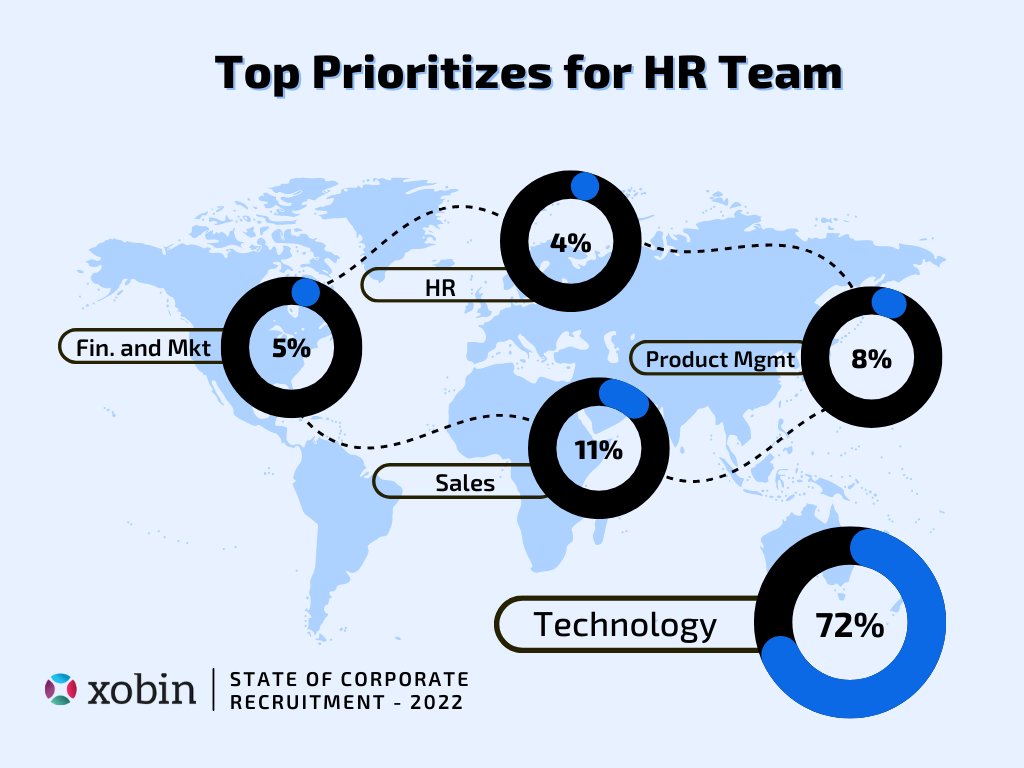
1. Recruiters facing challenges in hiring candidates for Technological roles: 72%
2. Hiring team who face challenges in recruiting Sales candidates: 11%
3. Recruiters who face challenges in hiring product management roles: 8%
4. Recruitment challenges in sourcing Human Resource candidates: 4%
5. Recruiters who face problems in hiring Finance and Marketing roles: 5%
Candidate offer acceptance ratios
In the segment above, we have seen the problems recruiters face in hiring for different job roles.
So After the crucial procedure of searching for the talent and interviewing them, the last thing recruiters want to hear is a ‘NO’ from candidates. But, unfortunately, most recruiters are facing a No Show or getting Ghosted from a candidate after joining the offer. As a result, candidates stop responding to any communication. For an employer, this costs a lot of time and money.
Key findings show that the major reason applicants do not accept the joining letter is getting better salaries in the market. Also, on the other hand, applicants getting retained by their current employer is the second reason.
So in our survey, we asked recruiters what the offer acceptance rate is? And how many offers are getting accepted?
Here are the key insights for these problems:

1. 2 Joining offers: 1 Offer Acceptance = 55%
2. 5 Joining offers: 1 Offer Acceptance = 32%
3. 10 Joining offers: 1 Offer Acceptance = 5%
4. 20 Joining offers: 1 Offer Acceptance = 2%
Reasons for employee resignation within the first year
Around 55% of employers say nearly 25% of their employees resign within the early days after joining an organization. Yes! You read it right. 0 to 25% of employees resign in the early days.
“If you do not treat people with the respect they deserve, do not expect any kind of commitment to your productivity goals and target.”
~ Ian Fuhr
So, what’s the reason behind employees resigning from their job? There are many shifts in employee choosing their work these days,
Employees not comfortable with the work model
Bad relationship with managers
Lack of work-life balance
High salary Expectations
Lack of interest in the job
How is this employee resignation a problem for employers?
Employers and recruiters face a challenge in retaining employees.
Hiring and training a new candidate is costly and takes a lot of time.
Creates an imbalance within the team.
Here’s an insight into the percentage of employees resigning from the organization within the 1st year of their joining.

1. Up to 25% of the resignations = 55%
2. Between 25 – 40% resignations = 31%
3. Between 40 – 55% resignations = 12%
4. Greater than 55% of the resignations = 3%
2. Stats on Workforce pain points
Stats on Workforce Struggles
So the above charts clearly show the shift in applicants’ thinking and how they want to work. Also, we have understood what problems recruiters are facing?
In our state of corporate recruitment 2022 survey, we tried to explore the problems to the core. So we asked our surveyors a question: What is the biggest struggle their organization is facing with the current workforce?
“Technology is nothing. What’s important is that you have faith in people, that they’re basically good and smart, and if you give them tools, they’ll do wonderful things with them.”
~ Steve Jobs
To understand this challenge inside the organization, we need to know what the workforce is? The workforce is the pool of people, both employed and unemployed. Out of this workforce, recruiters hire work-fit candidates for the job roles in the company.
Following key sentiments will show you the top challenges faced by recruiters in their organization,
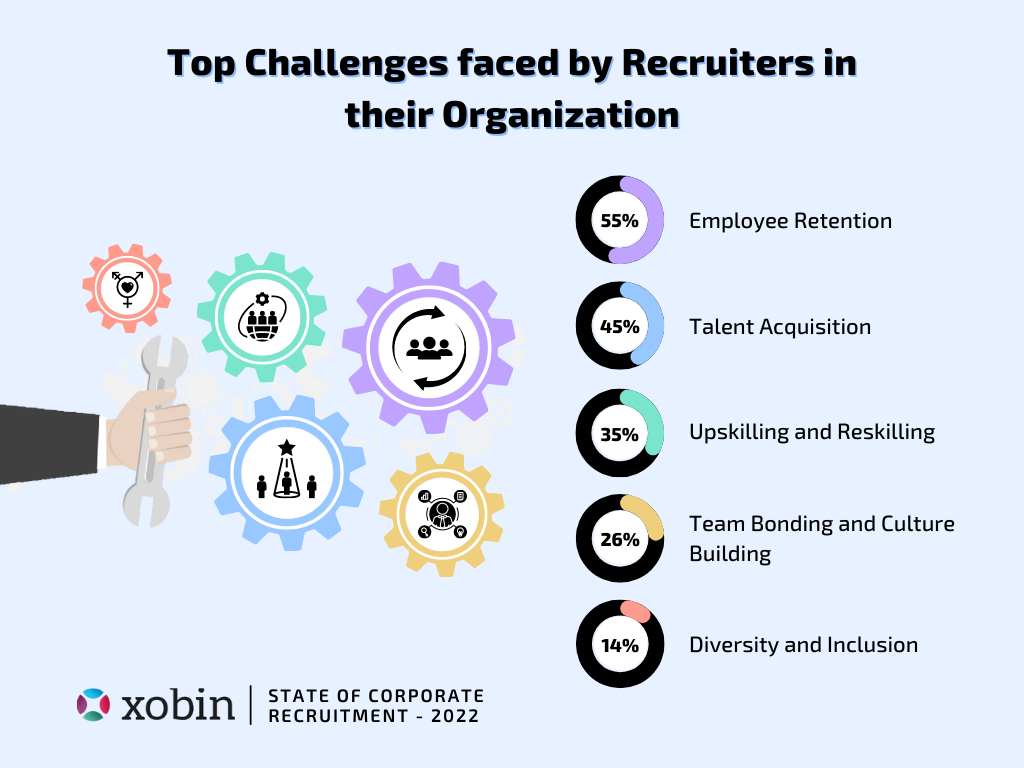
1. Employee retention = 55%
2. Talent Acquisition: Recruiting a fit candidate = 45%
3. Upskilling and Reskilling the candidates = 35%
4. Team bonding and culture-building = 26%
5. Diversity and Inclusion Struggles = 14%
Levels of Interviews in Organizations
According to research, companies had an average of 9 interview stages in 2019. And as a result of this, the job positions remained unfilled for an average of 29 days.
According to many candidates, numerous levels of interview pressurizes them. In addition to this, the long and hectic levels in hiring gave way to other fast recruiting companies. Must include high or low offer acceptance ratio.
Interestingly, with the shift and digitalization, none of the organizations have more than 6 interview levels
Take a look into other measures on the level of interviews.
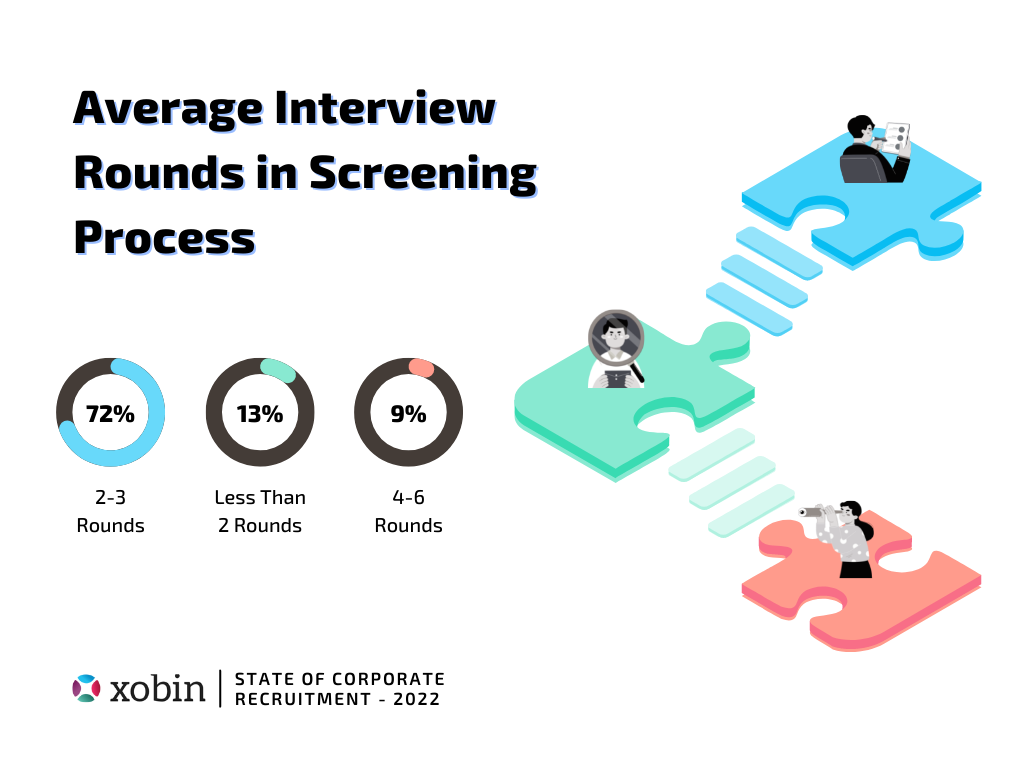
1. Less than 2 rounds of interviews= 13% of organizations
2. 2-3 rounds of interviews = 72% of organizations
3. 4-6 rounds of interviews = 9% of organizations
4. More than 6 Interviews rounds = None
The use of Software Tools in the Recruitment Process
According to the recruiter, new technologies and tools can significantly shift the hiring process. As many channels are available, hiring managers must try and use them to grow efficiency in recruiting.
For example, using the right software and tools will help them identify prospects who are the best fit. Social media plays a big role in sourcing candidates. In addition to that, some tools that make hiring efficient are video screening tools, resume parser, ATS and HRMS, and many more.
So what are these software solutions organizations use to make their hiring successful? Here is the rundown of the top 7 most used tools in the hiring process.
Software solutions used by organizations in the recruitment process:

1. Social media to source = 85%
2. ATS and HRMS tools = 55%
3. Use of Excel templates for tracking = 37%
4. Use of video and skill screening software = 22%
5. Resume parser tool = 13%
6. Predictive analysis tool = 8%
3. Know your process
More than 73 percent of employees are resigning because of higher salary expectations.
No employer wants resignations to happen in the organization. Training and replacing an employee costs time and money. No employer wants such turnover to happen in the company because of resignations.
So first of all, we need to know what employee resignation is?
Employee resignation is when the employee resigns voluntarily. It is like the employee is giving the notice before leaving the company. Such resignations may happen because of any reason. However, it can be a good thing because it makes them aware of the needs of their employees. Also, with the resignations, they may hire a new candidate with more strategic insights.
To know what are the main reasons behind the resignations we asked the recruiter: what is the reason their employee resigned from the company?
Here are a few insights on key reasons why employees resign from the job,

1. Poor relation with manager = 38.3%
2. Work-life balance = 55.31%
3. Salary expectations = 73.4%
4. Lack of interest = 24.5%
Higher number of recruiters believe one on one feedback creates engagement among remote employees.
Our above stat shows some key transitions in hybrid and remote working. Maintaining this balance and efficiency with these changes is a big task for employers.
It’s no myth today how big a role does employee engagement plays. Organizations, where employee engagement is high, have shown higher engagement and better outputs.
“Taking care of your employees is extremely important and very, very visible.”
~ Larry Ellison, Founder of Oracle
To understand where other organizations are facing challenges in creating better engagement. So what are the problems do current employees feel in engagement in companies? Here is a short list,
In building trust and engagement among employees.
Many employees don’t feel they have a good relationship with managers.
Lack of group activities.
Employees feeling less appreciated and valued.
The work environment in organizations.
Hence we tried to access what measures employers are taking to cope with this shift and make work more engaging for both employee and recruiter,

1. 53.7% of employers think giving one on one feedback creates employee trust and engagement.
2. 47.4% of recruiters accept investing in tools to make work more engaging and effective.
3. 47.4% of employers voted to give training to managers. As a result, they can make teamwork fruitful and engage with remote employees.
4. 52.7% of recruiters want group activities to be more engaging.
5. 53.7% of employers believe in celebrating individual performance.
About 40 percent of organizations have included referrals in their recruitment
It is still not old to think that things that go out of our mouths have less impact. Referrals are a perfect example of it. Companies and employers still count on it to make the right hiring decision.
For similar reasons employee referrals play an important role. Additionally, it has been a great source of hiring for companies, as well as employees getting the benefits.
According to study companies usually take more than 39 days to fill a job position. On the other end, it takes 29 days to fill a job position using employee referrals. Interestingly such benefits create trust among the team and build good connections.
We asked recruiters what the percentage of positions closed through referrals, to know how many companies are following with referrals programs.
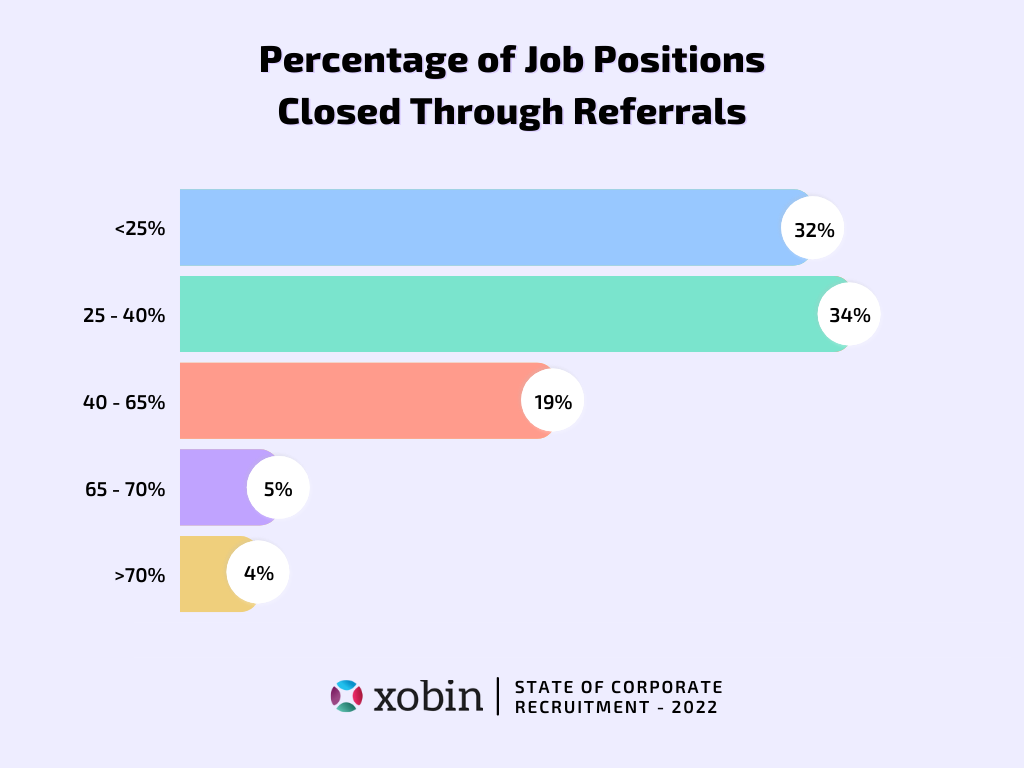
1. Less than 25% positions = 32% votes
2. 25 – 40% positions = 34% votes
3. 40 -65% positions = 19% votes
4. 65 – 70% positions = 5% votes
5. More than 70% positions = 4% votes
Above, we have seen the reasons behind employees resigning from their jobs. But on the other hand, as soon as these resignations are happening in the market, employers are forced to think of a good retention strategy.
So, what is a retention strategy?
A retention strategy is a method to understand the problems faced by the employees in the organization. Also, understanding and assessing and finding a way to fill these gaps. These gaps may be as,
Lack of recognition and benefits
Less satisfaction
Less pay
Lack of work-life balance
Fewer opportunities to grow
According to a few researchers, an exit interview of an employee gives insight into your employee retention strategies. If they leave the organization with good experience and support, it spreads the positive word about it.
Here are a few key retention strategies recruiters and employers think are good:
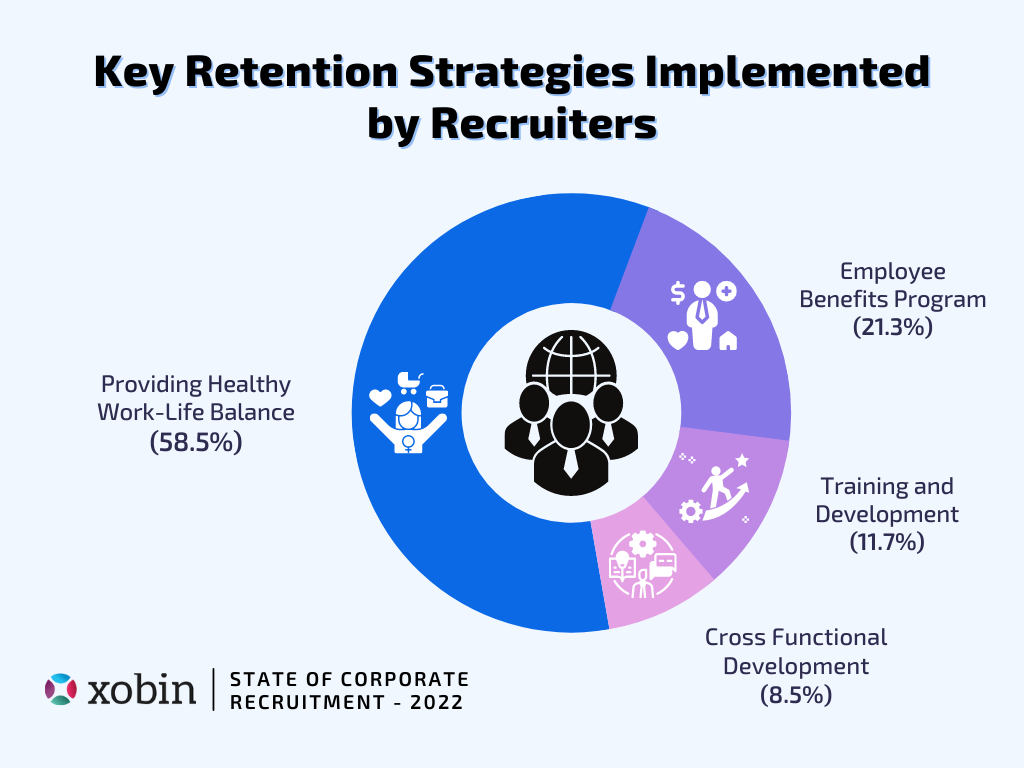
1. Cross-Functional Development = 8.5%
2. Training and Development = 11.7 %
3. Providing healthy work-life balance = 58.5%
4. Employee Benefits Program = 21.3%
4. Other key metrics for recruiters:
Now that you have gone through the insights let us leave you with a few more statistics,
1. According to a survey conducted by Linkedin, the most in-demand talent are in the software sector.
2. Millennials are the current big employees in the market. Gen z is a new and enthusiastic employee flow. Experts predict that by 2020, millennials will make up 35% of the global workforce with Gen Z making up 24%.
3. A Successful hire is measured in between the day of a candidate applying for a job and the day the candidate accepts a job offer. The Society for Human Resource Management (SHRM) reports an average time to fill of 36 days.
4. Temporary workers are growing in organizations. India currently has 1.3 million temporary workers in the organized sector. Deccan Herald predicted that by 2025, 10% of the overall workforce would be working as contingent workers through various staffing companies.
5. FlexJobs survey found that 58% of respondents would absolutely look for a new job if they cannot continue remote work.
6. As per a study by International Labour Organization, the current global labor force participation rate for women is just under 47%. For men, it’s 72%. That’s a difference of 25 percentage points, with some regions facing a gap of more than 50 percentage points.
Conclusion:
Xobin’s State of Corporate Recruitment Report is just another clear reminder for employers that job seekers and employees value flexibility. Accepting this changing work environment should now become a priority for employers.


